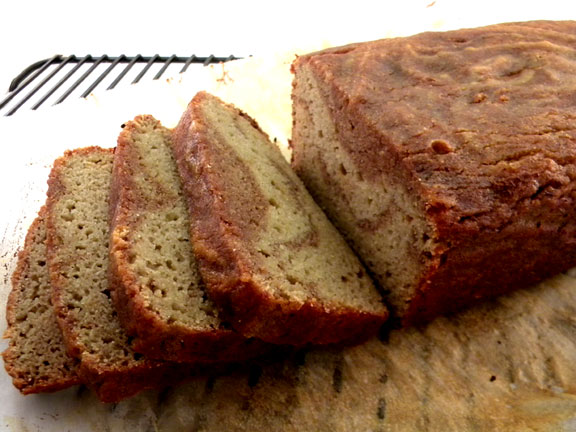- Home
- About
- Free eBook
- Contact
- Work With Me
- Recipes
- Blog
- How to Do
- How to cook and bake gluten-free
- How to bake with natural sweeteners
- How to Cook Fluffy, tasty Quinoa
- How to chop an onion
- How to open, shred, and make milk from a coconut
- How to Peel, Cut and Roast Butternut Squash
- How to select, prep and cook beans
- Peel Kiwi Fruit Perfectly with a Spoon and Knife
- THE MEANING BEHIND PRODUCE PLU CODES
- Resources
- Affiliates
Cinnamon Swirl Bread (Coconut Flour/Grain-Free/Gluten-Free/Dairy-Free)

Prep Time
15 min
Prep Notes
How to Cook With Coconut Flour
Due to its high fiber content, coconut flour acts like a sponge when you cook with it. Because of this absorbency, you can't simply replace the flour in every recipe with 100 percent coconut flour and expect it to turn out the way you're used to. If, for instance, you substitute one cup of wheat flour with one cup of coconut flour, you may end up with a mixture that's either too dry or falls apart.
As a general rule, however, you can easily replace up to 20 percent of the flour in any given recipe with coconut flour, and an equal amount of liquid, without compromising the taste or texture of the finished product.
For health purposes, however, including if you're interested in making a gluten-free baked good, it's better to use only coconut flour in your recipes. You need far less coconut flour than grain-based flour, so for every one cup of grain-based flour in a recipe use just one-quarter to one-third cup of coconut flour.
You should also add in one egg per ounce of coconut flour to take the place of gluten and help bind the mixture together.
If you don't have eggs on hand, you can also add in raw honey, hemp powder, chia seeds, or ground flax seeds (one tablespoon in three tablespoons of water makes a substitute for one egg) to bind the coconut flour together.
If you're using coconut flour in a typical grain-based flour recipe, you'll need to experiment a bit to get the proportions just right.
Adding more or less coconut flour will help you get the texture you love, and adding in the right mix of binding ingredients (such as eggs or flax seed) will ensure the baked good doesn't simply fall apart.
Cooking Time
45-100 min
Yields
1 loaf
Ingredients
Directions
- Preheat oven to 325°F. Be sure oven is preheated to the correct temperature before placing the loaf in the oven.
- Grease a loaf pan and line with parchment paper for complete ease in removal of loaf when done.
- If you are making your own applesauce, peel and core one apple, I used a Red Delicious. Dice into small pieces and place in a small saucepan with 1 tablespoon coconut oil and 1/4 cup water.
- Bring to a boil and simmer for five minutes. Turn off heat and allow to sit covered for ten minutes. The apples should be very soft. Mash with a fork or potato masher. Measure out 1/2 cup for the recipe.
- Measure out 2 tablespoons honey and place in a small bowl with 1 teaspoon cinnamon. Mix well. Set aside.
- Place eggs, honey, sea salt, vanilla, 1/2 teaspoon cinnamon and applesauce into a mixing bowl. If you didn’t make your own applesauce, add in one tablespoon melted coconut oil. With an electric mixer, mix at low speed until all ingredients are fully incorporated.
- To measure the coconut flour, pack firmly into the cup measurement and use the back of a straight knife to level the flour even with the top edge of the measuring cup.
- To ensure there are no lumps, sift flour.
- Begin by adding half of the coconut flour into the ingredients. Blend until well mixed and allow to sit for 2 minutes. Add remaining coconut flour to achieve a thick batter. It’s better to add flour in small amounts until you find the correct texture than to compensate by adding more liquids and fats.
- The batter for this loaf will be soft and fluffy in texture.
- Remove 1/2 cup of batter from the bowl and mix in with the honey and cinnamon mixture. Set aside.
- To the remaining batter, add baking soda and mix quickly and completely.
- Add apple cider vinegar and mix together quickly.
- Place one cup of batter into the loaf pan and spread out evenly using a spoon or spatula spreader. Spoon half of the cinnamon/honey mixture over the batter.
- Pour the remaining batter over the top of the cinnamon mixture and spread evenly to the sides. Pour the remainder of the cinnamon mixture on top and swirl with a knife.
- Place immediately into a preheated oven. Bake 45 minutes. Loaf will look nicely brown on top, firm on the sides but may be still slightly squishy at the center. If so, lightly cover with a tent of aluminum foil and bake 10 more minutes.
- At this point if the top still feels slightly squishy, turn off the oven and leave the loaf for 5 or 10 more minutes. This will usually allow the loaf to finish baking fully.
Notes
This bread is wonderful slathered with butter, nut better and fruit preserves, or best yet a mixture of butter, honey and cinnamon.
I use a very small loaf pan, since we know Paleo breads tend not to rise very much! I add extra baking time to it, as it is a deeper pan. Just about 100 minutes I baked mine, and it rose right up out of the pan. I use this pan here, and line it with parchment paper.


